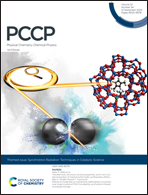Pt nanocluster size effects in the hydrogen evolution reaction: approaching the theoretical maximum activity†
Abstract
Hydrogen production from electrocatalytic water splitting in electrolyzers is a key process to store excess electric energy produced from intermittent renewable energy sources. For proton exchange membrane (PEM) electrolyzers, carbon supported platinum particles exhibit the highest rates for the hydrogen evolution reaction (HER); however, high Pt costs limit the wide spread use of this technology. By employing a graphene layer grown on a Ru(0001) single crystal as a template for Pt nanocluster (NC) growth, we studied the dependence of the HER activity on the NC size using NCs of different sizes. We provide clear quantitative experimental evidence for a volcano-like relationship between the HER activity and the NC size which has been missing so far. For Pt NCs with very low sizes below 2 nm, we found stunningly improved exchange HER current densities. The highest exchange current density was observed for Pt NCs with an average size of ca. 38 atoms. These Pt38 NCs do not only surpass the Pt-mass-specific activity of commercial Pt electrode materials by well above three orders of magnitude, also their exchange current density is located close to the maximum exchange current density for the HER predicted theoretically for transition metal surfaces. The present work provides a strong stimulus for future research towards technically feasible Pt NC catalysts with cluster sizes in the range of few tens of Pt atoms.

- This article is part of the themed collection: 2020 PCCP HOT Articles


 Please wait while we load your content...
Please wait while we load your content...